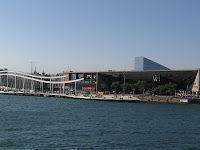 Right by the sea of Barcelona lies the hill of Montjuïc, which can be easily spotted from mid-air on the plane.
Right by the sea of Barcelona lies the hill of Montjuïc, which can be easily spotted from mid-air on the plane.巴塞羅那海邊有座小山,名為蒙錐山(Montjuïc),從飛機上望過去很是突出。
 Montjuïc is not more than another place or tourist spot of Barcelona. It’s the place that supplies a lot of the stones used for construction works, from the lowly homes to the holy La Sagrada Família cathedral.
Montjuïc is not more than another place or tourist spot of Barcelona. It’s the place that supplies a lot of the stones used for construction works, from the lowly homes to the holy La Sagrada Família cathedral.蒙錐山對巴塞羅那有多重要?先說巴塞羅那的建築,不論是高廸設計的聖家大教堂(La Sagrada Família),或是其他樓房,材料往往用得上取自蒙錐山的石。
It’s also a militarily strategic location as it commands a totally unobstructed view of the port at the foot of the hill. The castle at the summit of the hill (Castell de Montjuïc) was originally built for this purpose, but it was also the site where political dissidents had their lives ended under the various regimes in history. Now the castle is turned into a military museum (Museu Militar).
此山屹立於海濱,港口盡收眼底,保衛海港的軍事要塞,位置不用作他選了,所以山頂便建了座堡壘(Castell de Montjuïc)。堡壘有過一段不光采的歷史,曾是歷年來處決政治異己之地,不過現在已成為軍事博物館(Museu Militar)。



The container port of Barcelona (also see the video below)
巴塞羅那的貨櫃碼頭(亦可看以下短片)



Museu Militar
軍事博物館

Absolute protection
保衛海港的大炮
Many of the venues of the 1992 Olympics, including the Olympic Stadium, were situated in Montjuïc. The few memories I had from the TV footages of that Olympics suddenly became very real as I had a peek into the nondescript and almost deserted Piscines Municipals de Montjuïc (Montjuïc municipal swimming pools). I could almost see Olympic divers somersaulting in mid-air against the backdrop of the city, like I did back in 1992!
1992年舉辦的奧運會,主場館及不少其他設施都位於蒙錐山,走過市政游泳池(Piscines Municipals de Montjuïc)時,好奇看看鐵閘後有何乾坤,第一眼的景色,馬上令我回想起當年看跳水比賽的片段——我還記得場館的背景便是巴塞羅那市區密密麻麻的房屋,這次給我找到當年鏡頭的角度了!

The Olympic Stadium
主場館


The sqaure and the Olympic Cauldron in front of the stadium
主場館前的廣場及火炬台


Take the plunge! 尋找當年的記憶
The expo of 1929 was another major event hosted at Montjuïc. Some of the installations were kept after all those years, like the Palau Nacional (National Palace) which now houses the Museu Nacional d’Art de Catalunya (National Museum of Catalonian Art). The three water cascades on the way downhill from the museum, each looking different from the other ones, added to the grandeur of the museum. At the bottom cascade was a square with the Font Màgica (Magic Fountain) that keeps changing its flow every moment. The street in front of the fountain led to Plaça Espanya (Spain Square), and on my day of visit it was closed off for an exhibition. The original function of the place was obviously not lost!
蒙錐山還是1929年舉辦世界博覽會的地方,當年興建的國立宮殿(Palau Nacional),現已是國立卡泰隆藝術博物館(Museu Nacional d’Art de Catalunya),從博物館走下山,經過三層瀑布,每層各有景緻,到達最底層的廣場時,便感受到整個佈局的不凡氣派。廣場中央的魔幻噴泉(Font Màgica),會隨不同時間噴出各樣的花式,對着噴泉的大街,直通西班牙廣場(Plaça Espanya),我遊覽那天正舉辦時裝展覽,整條大街都封閉,可見那裡由當年至今仍扮起展覽功能。


Palau Nacional, now home to the Museu Nacional d’Art de Catalunya
國立宮殿,為國立卡泰隆藝術博物館之現址

Font Màgica and the Plaça Espanya further beyond
魔幻噴泉及再遠一點的西班牙廣場
 The 1992 Olympics brought about a large-scale urban renewal, and the seaside underwent a facelift. One of the best ways to enjoy the long coast line of Barcelona was by taking a cruise.
The 1992 Olympics brought about a large-scale urban renewal, and the seaside underwent a facelift. One of the best ways to enjoy the long coast line of Barcelona was by taking a cruise.92年奧運,帶動都市翻新,海濱便因要舉辦賽事而重建。巴塞羅那長長的海濱,要一次過欣賞的話,坐觀光船是個不錯的選擇。
The boat cruise I took had to negotiate some high winds and rather choppy waters, but none of us passengers were too bothered. Windsurfers really rejoiced in those conditions, and there were so many of them in the sea. A couple of them really caught our eyes as they leapt into the air!
坐船那天風高浪急,但無損各人遊船河的興緻,沿途更看不到不少滑浪風帆,在海中風馳電掣,偶爾還看到有一兩隻風帆飛躍空中,很是神氣。

The port for cruise liners (Port d'Europa) from afar
遠望郵輪港


The coastline of Barcelona 巴塞羅那的海岸線

Flying through the sea!
碧波中翱翔
The pier from which my cruise departed were also renovated with a new bridge (Rambla del Mar) linking the pier to the MareMagnum shopping arcade and the adjoining cinema. That place reminded me somewhat of Darling Harbour in Sydney.
觀光船碼頭一帶也因應奧運而改頭,有一條新建的橋Rambla del Mar把碼頭連接到MareMagnum商場及相連的戲院,感覺有點像澳洲悉尼的達令港(Darling Harbour)。


At the pier for the boat cruise 坐船河的碼頭


Rambla del Mar and the MareMagnum
MareMagnum商場及相連的Rambla del Mar橋
The seaside district of Barceloneta awaited after taking a bend at the end of the promenade from the pier. Apart from the string of beaches along the coast, Barceloneta also had a parade of restaurants along one of its main streets. Seafood was the obvious choice when dining in a seaside setting, so I tried the Arroz Negro, which looked like ‘black paella’ of some kind cooked with squid ink.
從碼頭沿着海濱大道拐個彎,便來到Barceloneta區,那裡除了連綿海灘外,還有一整條盡是食肆的街,既然是海邊,自然便想起吃海鮮,結果吃了一客黑海鮮飯(Arroz Negro),這個用墨魚汁弄的飯,跟一般的海鮮飯(Paella)各有千秋,熱騰騰一鍋很是不錯。


Barceloneta behind the sea of yachts
千帆待發的Barceloneta


Welcome to a world of fantasy - and seafood!
充滿創意的海濱大道

Arroz Negro, sizzling hot
黑海鮮飯
My two trips through Spain, this year and last year, gave me a taste of the diversity of the country. Enough people have said good things about the South, and I really look forward to another trip to experience its sunshine, cuisine and atmosphere!
去年和這次來西班牙,令我體會到西班牙不同地方多姿多采的文化,聽說南部也有另一番風情,真想親身感受一下,享受陽光、美食和那裡的風土人情!
Comments
i might be visiting Europe early next year, that's why wanna be First to follow yr blog, yeah! ^0^